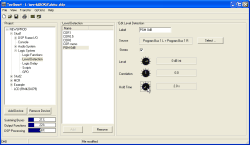With the Logic System of RM4200D you can monitor the levels and correlation degree of up to five audio signals at the same time. Level Detectors configured accordingly control logic functions that are activated when the level exceeds a preset threshold. These logic functions are available in the Logic Sources Window under Level Detect/LV <Label> or Correlation Detect/LC <Label>. For each entry in the list Detection, in the Logic Sources Window for Level Detect and Correlation Detect an entry each is added.
The state of the logic function can be output e.g. using a GPO or displayed in the LED of a User Defined key on the Control Module.
To insert a new Level and Correlation Detect into the list Level Detection, use the button . In order to delete it, mark the entry and click on the button . Both functions are also available in the contextual menu.
After highlighting an entry in the list Level Detection, you can configure the Level Detect in the pane Edit Level Detection of the dialog:
First enter a name for the function in the field Label. This may be up to 10 characters long.
Now click on the button , to open or activate the Audio Sources Window. Select the audio signal that you want to monitor and assign it as Source. To do that, either use the button , drag&drop or double click on the desired audio source.
When you click on the checkbox Stereo, in addition, the subsequent channel is automatically selected for monitoring. In most cases, this is the right channel of a stereo signal.
Now adjust the desired threshold using the potentiometer Level. You can set it between -40dBint and +10dBint in steps of 1dB.
Using the potentiometer Correlation, you can set a correlation degree value between -1.0 and 1.0, independent from the set threshold at the Level potentiometer. The logic function Correlation Detect/LC <Label> becomes active when exceeding this value.
With the potentiometer Hold Time you can adjust for how long the logic functions Level Detect/LV <Label> or Correlation Detect/LC <Label> remain active after exceeding the threshold. You can set this hold time between 0,1s and 100s.
To adjust the potentiometers, first click on the desired button. Hold the mouse key down and move the cursor to the left or to the right to change the value. Alternatively, you can also click on a potentiometer button, hold the mouse key and change the value with the following keys:
| Level Potentiometer | Correlation Potentiometer | Hold Time Potentiometer | Cursor keys |
|---|---|---|---|
| + 1dB-steps | +0,1-steps | + 0,1s-steps | Arrow right or arrow up |
| - 1dB-steps | -0,1-steps | - 0,1s-steps | Arrow left or arrow down |
| - 40dBint | -1,0 | 0,1s | Pos 1 |
| +10dBint | +1,0 | 100s | End |
| + 10dB-steps | +1,0-steps | + 1s-steps | PageUp |
| - 10dB-steps | -1,0-steps | - 1s-steps | PageDown |
The level detectors can be inverted as Logic Sources in logic functions or GPOs to detect an underrun of the level. By AND-linking in a logic function with the Logic Source Pulse 1 (or 2, 3), you can also configure flashing functions for exceeding or underrunning of levels.
The correlation degree detectors can be used as Logic Source to detect whether both parts of a stereo signal are equal (1) or at least related (0.1-0.9) . In the negative range, the Logic Source displays faulty stereo signals that are not qualify for mono generation.
